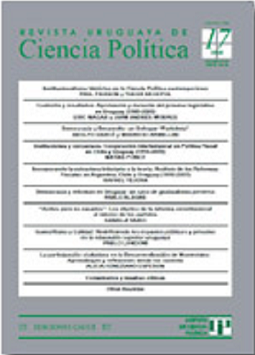Coalición y resultados
aprobación y duración del trámite parlamentario en Uruguay (1985-2000)
Palabras clave:
Parlamento, Poder Ejecutivo, Coalición de GobiernoResumen
En este trabajo exploramos el proceso legislativo en busca de algunas supuestas consecuencias de los gabinetes de coalición en un sistema presidencial. Los efectos de la coalición no deben esperarse en relación al éxito de las iniciativas del Ejecutivo: el comportamiento estratégico invalida esta medida intuitiva de desempeño. Una mejor medida de los efectos de la coalición es la tasa de éxito de los legisladores de la coalición, y el tiempo que requieren las propuestas para ser aprobadas. Medidos de esta manera los efectos de la coalición son perceptibles. El análisis del universo de las propuestas procesadas por el Parlamento uruguayo entre 1985 y 2000 revela que la coalición aumenta la tasa de éxito de los miembros de la coalición en un 60% en promedio (y por tanto como 150%). El análisis de eventos históricos muestra que las coaliciones acortan el tiempo de espera para un proyecto de ley del Ejecutivo en 3 meses, un sexto del tiempo de espera promedio. El efecto inverso se hace sentir en la duración de los proyectos de ley de los legisladores, especialmente aquellos cercanos al Presidente.
Descargas
Referencias
Altman, David (2000). "The Politics of Coalition Formation and Survival in Multi-Party Presidential Democracies: The Case of Uruguay, 1989—1999", en Party Politics 6(3):259-283.
Amorim Neto, Octavio (2006). "The Presidential Calculus: Executive Policy Making and Cabinet Formation in the Americas", en Comparative Political Studies 39(4):415-440.
Baum, Matthew A. y Samuel Kernell (1999). "Has Cable Ended the Golden Age of Presidential Television?", en American Political Science Review 93(1):99-114.
Becker, Rolf y Thomas Saalfeld (2004). "The life and times of Bills", en Döring, Herbert y Mark Hallerberg (eds.), Patterns of Parliamentary Government: Passage of Legislation across Western Europe. Aldershot, England: Ashgate.
Box-Steffensmeier, Janet y Bradford S. Jones (2004). Event History Modeling: A Guide for Social Scientists. New York: Cambridge University Press.
Buquet, Daniel, Daniel Chasquetti y Juan Andrés Moraes (1998). Fragmentación política y gobierno en Uruguay: ¿un enfermo imagnario? Montevideo: Instituto de Ciencia Política, Facultad de Ciencias Sociales.
Caetano, Gerardo, José Rilla y Romeo Pérez (1988). "La partidocracia uruguaya", en Cuadernos del CLAEH 44:37-62.
Cameron, Charles M. (2000). Veto Bargaining: Presidents and the Politics of Negative Power. New York: Cambridge University Press.
Carey, John M. (2002). Parties, Coalitions, and the Chilean Congress in the 1990s, en Morgenstern y Benito Nacif (eds), Legislative Politics in Latin America. New York: Cambridge University Press.
Carey, John M. y Matthew Soberg Shugart, eds. (1998). Executive Decree Authority. New York: Cambridge University Press.
Carey, John M., Octávio Amorim Neto y Matthew Soberg Shugart (1997). "Appendix: Outline of the Constitutional Powers in Latin America", en Mainwaring, Scott y Matthew Soberg Shugart (eds.), Presidentialism and Democracy in Latin America. New York: Cambridge University Press pp. 440--60.
Chasquetti, Daniel. 1999. "Compartiendo el gobierno: multipartidismo y coaliciones en el Uruguay (1971-1997)", en Revista Uruguaya de Ciencia Política N°10 (1).
Cheibub, José Antonio, Adam Przeworski y Sebastián M. Saiegh (2004). "Government Coalitions and Legislative Success Under Presidentialism and Parliamentarism", en British Journal of Political Science 34:565-587.
Cox, Gary W. (1987). The Efficient Secret: The Cabinet and the Development of Political Parties in Victorian England. New York: Cambridge University Press.
Cox, Gary W. y Frances Rosenbluth (1993). "The electoral fortunes of legislative factions in Japan", en American Political Science Review 87(3):577-589.
Cox, Gary W. y Mathew D. McCubbins (2005). Setting the Agenda: Responsible Party Government in the US House of Representatives. New York: Cambridge University Press.
Crisp, Brian F. (2000). Democratic Institutional Design: The Powers and Incentives of Venezuelan Politicians and Interest Groups. Palo Alto: Stanford University Press.
González, Luis E. (1991). Political Structures and Democracy in Uruguay. Notre Dame: University of Notre Dame Press.
Haggard, Stephan y Mathew D. McCubbins (2001). Presidents, Parliaments, and Policy. New York: Cambridge University Press.
Indridason, Indridi H. (2000). "Process, Politics and Institutions: Three Essays in Positive Political Theory". Ph.D. dissertation University of Rochester.
Jones, Mark P. (1995a) Electoral Laws and the Survival of Presidential Democracies. Notre Dame: University of Notre Dame Press.
Jones, Mark P. (1995b). "A Guide to the Electoral Systems of the Americas", en Electoral Studies 14(1):5-21.
Jones, Mark P. y Wonjae Hwang (2005). "Party Government in Presidential Democracies: Extending Cartel and CPG Theory beyond the U.S. Congress", en' American Journal of Political Science 49(2):267-282.
King, Gary, Michael Tomz y Jason Wittenberg (2000). "Making the Most of Statistical Analyses: Improving Interpretation and Presentation", en American Journal of Political Science 44(2):347-361.
Laakso, Marku y Rein Taagepera (1979). "Effective Number of Parties: A Measure with Application to Western Europe", en Comparative Political Studies 12(1):3--27.
Laver, Michael (2006). "Legislatures and Parliaments in Comparative Context", en Weingast, Barry R. y Donald A. Wittman (eds.), The Oxford Handbook of Political Economy. New York: Oxford University Press pp. 121-140.
Laver, Michael y Kenneth A. Shepsle (1990). "Coalitions and Cabinet Government", en American Political Science Review 84(3):873-890.
Laver, Michael y Norman Schofield (1991). Multiparty Government: The Politics of Coalition in Europe. Oxford: Oxford University Press.
Linz, Juan J. (1990). "The Perils of Presidentialism", en Journal of Democracy 1(1):51-69.
Londregan, John B. (2000). Legislative Institutions and Ideology in Chile's Democratic Transition. New York: Cambridge University Press.
Magar, Eric. (2001). "Bully Pulpits: Posturing, Bargaining, and Polarization in the Legislative Process of the Americas". PhD. dissertation University of California, San Diego.
Magar, Eric. (s/f). "Bully pulpits: Veto politics in the legislative process of the Americas". Manuscrito inédito, ITAM.
Mainwaring, Scott (1993). "Presidentialism, Multipartism, and Democracy: The Difficult Combination", en Comparative Political Studies 26(2):198--228.
Mainwaring, Scott y Matthew Soberg Shugart (1997). Presidentialism and Democracy in Latin America. New York: Cambridge University Press.
Masuyama, Mikitaka (2001). "Agenda power in the Japanese Diet: A duration analysis of lawmaking". PhD. dissertation University of Michigan.
McCubbins, Mathew D. y Michael F. Thies (1997). "As a matter of faction: The budgetary implications of factional control in Japan's LDP", en Legislative Studies Quarterly 22(3):293-328.
Morgenstern, Scott (2001). "Organized factions and Disorganized Parties: Electoral Incentives in Uruguay", en Party Politics 7(2):235-256.
Morgenstern, Scott (2003). Patterns of Legislative Politics: Roll-Call Voting in Latin America and the United States. New York: Cambridge University Press.
Peters, B. Guy (1997). "The Separation of Powers in Parliamentary Systems", en Von Mettenheim, Kurt (ed.), Presidential Institutions and Democratic Politics. Baltimore: Johns Hopkins University Press pp. 67-83.
R Development Core Team (2006). R: A Language and Environment for Statistical Computing. Vienna, Austria: R Foundation for Statistical Computing.
Reglamento de la Cámara de Representantes (1991). Última modificación del 4 de Noviembre de 1998. Disponible en www.parlamento.gub.uy (Visitado el 8 de mayo de 2007). Poder Legislativo de la Reública Oriental del Uruguay.
Romer, Thomas y Howard Rosenthal (1978). "Political Resource Allocation, Controlled Agendas, and the Status Quo", en Public Choice 33:27-44.
Samuels, David (2003). Ambition, Federalism, and Legislative Politics in Brazil. New York: Cambridge University Press.
Shugart, Matthew Soberg y John M. Carey (1992). Presidents and Assemblies: Constitutional Design and Electoral Dynamics. New York: Cambridge University Press.
Siavelis, Peter M. (2000). The President and Congress in Postauthoritarian Chile: Institutional Constraints to Democratic Consolidation. University Park: Pennsylania State University Press.
Stata (2003). Stata Release 8. College Station, TX: Stata Corporation.
Strom, Kaare (1990). Minority government and majority rule. New York: Cambridge University Press.
Tomz, Michael, Jason Wittenberg y Gary King (2001). "CLARIFY: Software for Interpreting and Presenting Statistical Results. Version 2.0.
Warwick, Paul V. y James N. Druckman (2001). "Portfolio Salience and the Proportionality of Payoffs in Coalition Governments", en British Journal of Political Science 31(4):627-649.



























